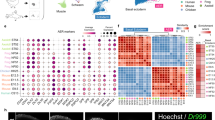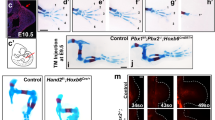Abstract
Vertebrate HoxA and HoxD cluster genes are required for proper limb development1,2,3. However, early lethality, compensation and redundancy have made a full assessment of their function difficult3,4,5. Here we describe mice that are lacking all Hoxa and Hoxd functions in their forelimbs. We show that such limbs are arrested early in their developmental patterning and display severe truncations of distal elements, partly owing to the absence of Sonic hedgehog expression. These results indicate that the evolutionary recruitment of Hox gene function into growing appendages might have been crucial in implementing hedgehog signalling, subsequently leading to the distal extension of tetrapod appendages. Accordingly, these mutant limbs may be reminiscent of an ancestral trunk extension, related to that proposed for arthropods6.
This is a preview of subscription content, access via your institution
Access options
Subscribe to this journal
Receive 51 print issues and online access
$199.00 per year
only $3.90 per issue
Buy this article
- Purchase on Springer Link
- Instant access to full article PDF
Prices may be subject to local taxes which are calculated during checkout




Similar content being viewed by others
References
Zakany, J., Kmita, M. & Duboule, D. A dual role for Hox genes in limb anterior–posterior asymmetry. Science 304, 1669–1672 (2004)
Davis, A. P., Witte, D. P., Hsieh-Li, H. M., Potter, S. S. & Capecchi, M. R. Absence of radius and ulna in mice lacking hoxa-11 and hoxd-11. Nature 375, 791–795 (1995)
Fromental-Ramain, C. et al. Hoxa-13 and Hoxd-13 play a crucial role in the patterning of the limb autopod. Development 122, 2997–3011 (1996)
Favier, B. et al. Functional cooperation between the non-paralogous genes Hoxa-10 and Hoxd-11 in the developing forelimb and axial skeleton. Development 122, 449–460 (1996)
Wellik, D. M. & Capecchi, M. R. Hox10 and Hox11 genes are required to globally pattern the mammalian skeleton. Science 301, 363–367 (2003)
Snodgrass, R. E. Principles of Insect Morphology (McGraw-Hill, New York, 1935)
Riddle, R. D., Johnson, R. L., Laufer, E. & Tabin, C. Sonic hedgehog mediates the polarizing activity of the ZPA. Cell 75, 1401–1416 (1993)
Suemori, H. & Noguchi, S. Hox C cluster genes are dispensable for overall body plan of mouse embryonic development. Dev. Biol. 220, 333–342 (2000)
Medina-Martinez, O., Bradley, A. & Ramirez-Solis, R. A large targeted deletion of Hoxb1–Hoxb9 produces a series of single-segment anterior homeotic transformations. Dev. Biol. 222, 71–83 (2000)
Logan, M. et al. Expression of Cre recombinase in the developing mouse limb bud driven by a Prxl enhancer. Genesis 33, 77–80 (2002)
Spitz, F. et al. Large scale transgenic and cluster deletion analysis of the HoxD complex separate an ancestral regulatory module from evolutionary innovations. Genes Dev. 15, 2209–2214 (2001)
Rallis, C. et al. Tbx5 is required for forelimb bud formation and continued outgrowth. Development 130, 2741–2751 (2003)
van den Akker, E. et al. Axial skeletal patterning in mice lacking all paralogous group 8 Hox genes. Development 128, 1911–1921 (2001)
Fromental-Ramain, C. et al. Specific and redundant functions of the paralogous Hoxa-9 and Hoxd-9 genes in forelimb and axial skeleton patterning. Development 122, 461–472 (1996)
Harfe, B. D. et al. Evidence for an expansion-based temporal Shh gradient in specifying vertebrate digit identities. Cell 118, 517–528 (2004)
Chiang, C. et al. Manifestation of the limb prepattern: limb development in the absence of sonic hedgehog function. Dev. Biol. 236, 421–435 (2001)
Kraus, P., Fraidenraich, D. & Loomis, C. A. Some distal limb structures develop in mice lacking Sonic hedgehog signalling. Mech. Dev. 100, 45–58 (2001)
Lewis, P. M. et al. Cholesterol modification of sonic hedgehog is required for long-range signalling activity and effective modulation of signaling by Ptc1. Cell 105, 599–612 (2001)
Ros, M. A. et al. The chick oligozeugodactyly (ozd) mutant lacks sonic hedgehog function in the limb. Development 130, 527–537 (2003)
Knezevic, V. et al. Hoxd-12 differentially affects preaxial and postaxial chondrogenic branches in the limb and regulates Sonic hedgehog in a positive feedback loop. Development 124, 4523–4536 (1997)
Litingtung, Y., Dahn, R. D., Li, Y., Fallon, J. F. & Chiang, C. Shh and Gli3 are dispensable for limb skeleton formation but regulate digit number and identity. Nature 418, 979–983 (2002)
te Welscher, P. et al. Progression of vertebrate limb development through SHH-mediated counteraction of GLI3. Science 298, 827–830 (2002)
Sordino, P. D. D. A molecular approach to the evolution of vertebrate paired appendages. Trends Ecol. Evol. 11, 114–119 (1996)
Gonzalez-Crespo, S. et al. Antagonism between extradenticle function and Hedgehog signalling in the developing limb. Nature 394, 196–200 (1998)
Mercader, N. et al. Conserved regulation of proximodistal limb axis development by Meis1/Hth. Nature 402, 425–429 (1999)
Capdevila, J., Tsukui, T., Rodriquez Esteban, C., Zappavigna, V. & Izpisua Belmonte, J. C. Control of vertebrate limb outgrowth by the proximal factor Meis2 and distal antagonism of BMPs by Gremlin. Mol. Cell 4, 839–849 (1999)
Shubin, N., Tabin, C. & Carroll, S. Fossils, genes and the evolution of animal limbs. Nature 388, 639–648 (1997)
Tabin, C. J. & Laufer, E. Hox genes and the evolutionary origin of the serial homology between fore and hind limbs. Nature 361, 692–693 (1993)
Dupe, V. et al. In vivo functional analysis of the Hoxa-1 3′ retinoic acid response element (3′RARE). Development 124, 399–410 (1997)
Acknowledgements
We thank A. McMahon, M. Torres, G. Martin, A. Ruiz I Altaba, C. Fromental-Ramain and E. Olson for probes, N. Fraudeau and M. Friedli for technical assistance, and J. Deschamps, G. Morata and P. Vassalli for discussions. This work was supported by funds from the canton de Genève, the Claraz and Louis Jeantet foundations, the Swiss National Research Fund, the NCCR ‘Frontiers in Genetics’ (to D.D.), a grant from the National Institutes of Health (to C.T.) and the EMBO young investigator program (to M.L.).
Author information
Authors and Affiliations
Corresponding author
Ethics declarations
Competing interests
Reprints and permissions information is available at npg.nature.com/reprintsandpermissions. The authors declare no competing financial interests.
Rights and permissions
About this article
Cite this article
Kmita, M., Tarchini, B., Zàkàny, J. et al. Early developmental arrest of mammalian limbs lacking HoxA/HoxD gene function. Nature 435, 1113–1116 (2005). https://doi.org/10.1038/nature03648
Received:
Accepted:
Issue Date:
DOI: https://doi.org/10.1038/nature03648
This article is cited by
-
Regulation of chromatin organization during animal regeneration
Cell Regeneration (2023)
-
A spatio-temporally constrained gene regulatory network directed by PBX1/2 acquires limb patterning specificity via HAND2
Nature Communications (2023)
-
Etv2 regulates enhancer chromatin status to initiate Shh expression in the limb bud
Nature Communications (2022)
-
The molecular genetics of human appendicular skeleton
Molecular Genetics and Genomics (2022)
-
Control of mouse limb initiation and antero-posterior patterning by Meis transcription factors
Nature Communications (2021)
Comments
By submitting a comment you agree to abide by our Terms and Community Guidelines. If you find something abusive or that does not comply with our terms or guidelines please flag it as inappropriate.



